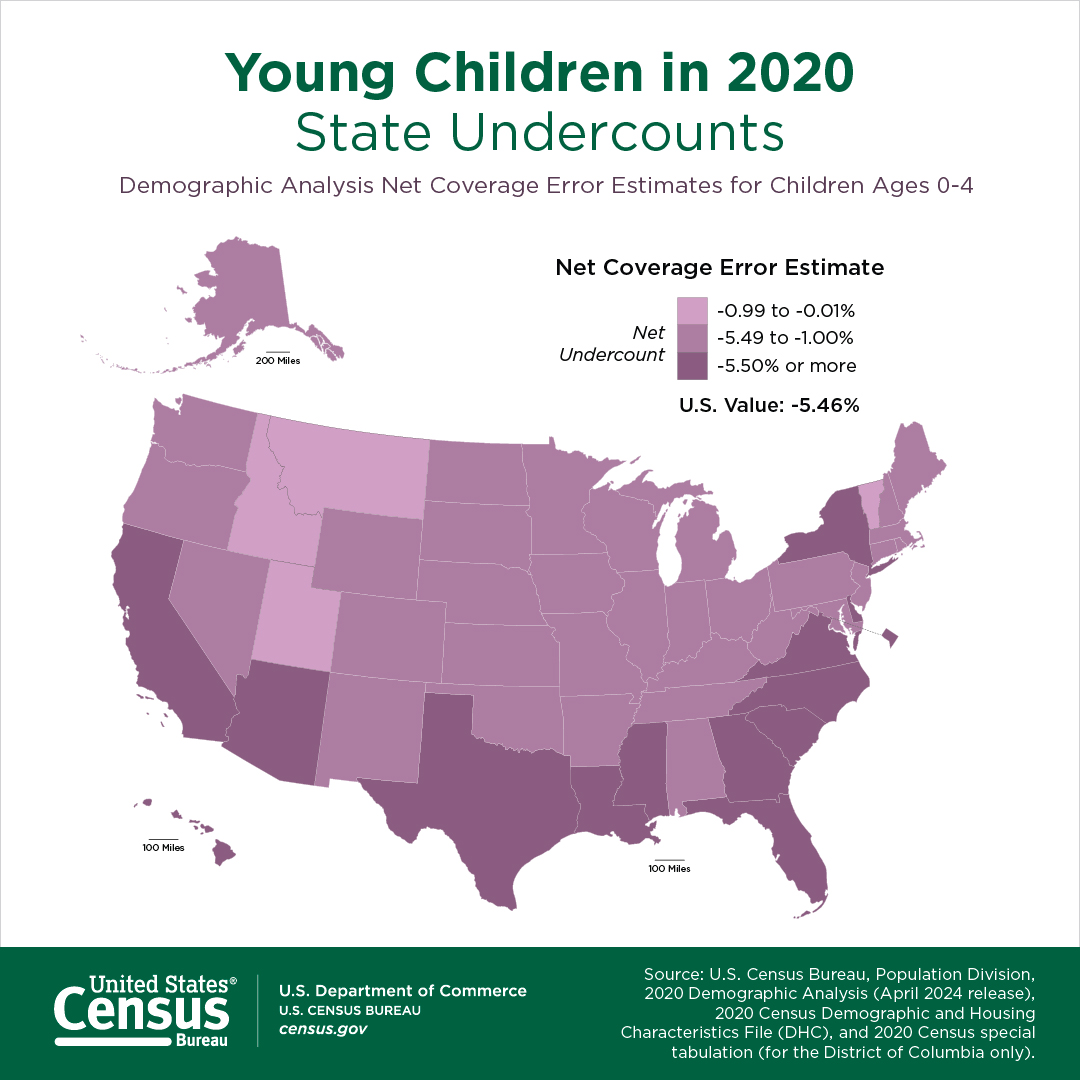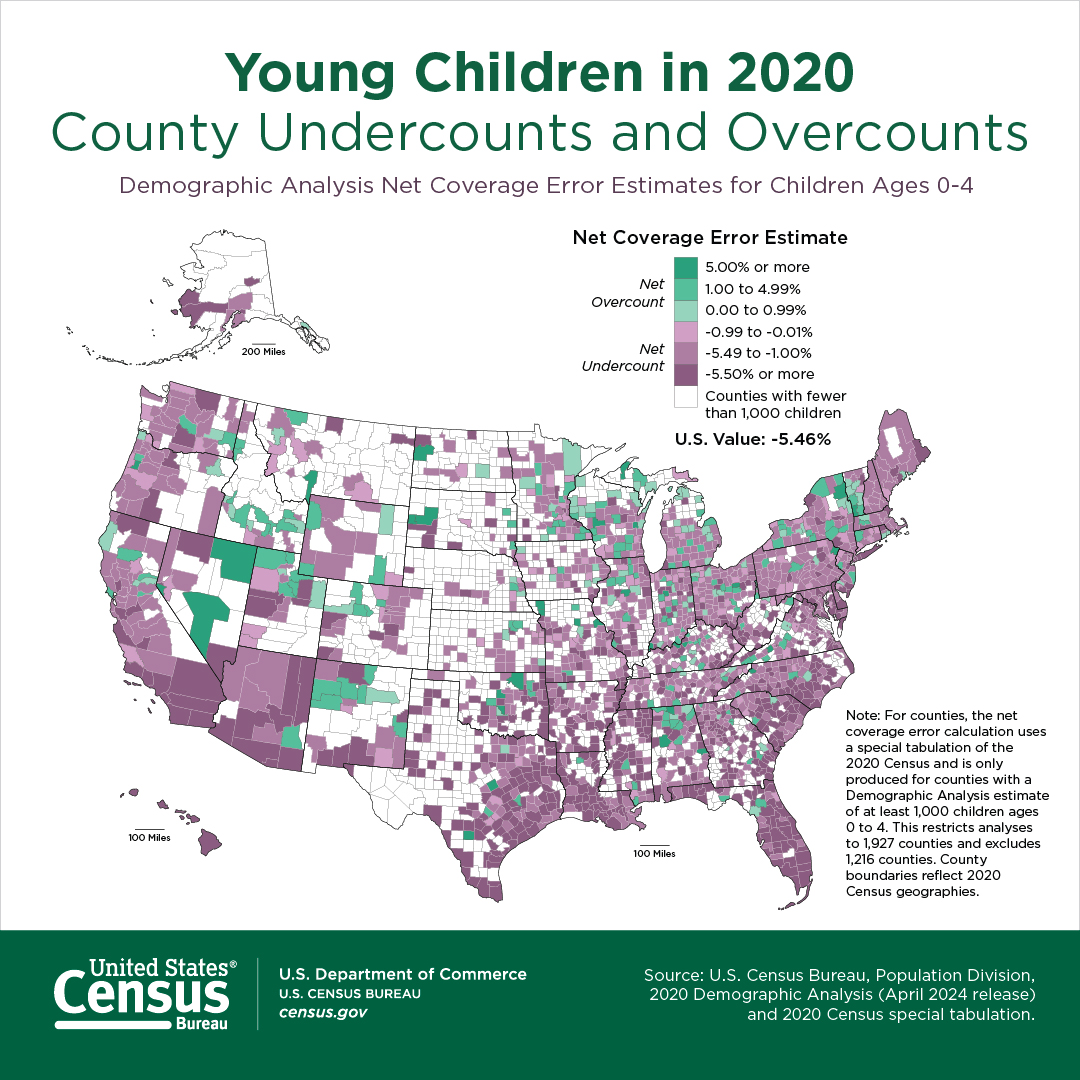Census Bureau Releases Experimental Estimates of State and County Undercounts and Overcounts of Young Children in the 2020 Census
For Immediate Release: Thursday, April 11, 2024
Census Bureau Releases Experimental Estimates of State and County Undercounts and Overcounts of Young Children in the 2020 Census
Census Bureau Initiatives to Address Persistent Undercount of Children
APRIL 11, 2024 – The U.S. Census Bureau today released new experimental estimates showing children ages 0 to 4 were undercounted in the 2020 Census in every state. Additionally, there were undercounts of children ages 0 to 4 in more than 4 out of 5 counties included in this release. The experimental estimates are available only for counties with a population of 1,000 or more children ages 0 to 4, and are based on the Census Bureau’s Demographic Analysis (DA) estimates.
The number of U.S. children ages 0 to 4 counted in the 2020 Census was previously found to be about 1 million lower than the benchmark population estimate — an undercount of 5.46%. This was a larger undercount than any other age group.
Today’s release of net coverage error rates for young children comes from the Census Bureau’s DA estimates. Instead of conducting a count based on responses collected or on behalf of each household like the 2020 Census, DA uses administrative records to estimate the size of the population and compares those estimates to census counts to assess the accuracy of the 2020 Census.
“The Census Bureau recognizes historical undercounts of young children in our decennial census as well as an under-representation in our demographic surveys. We know these undercounts are often correlated with undercounts of certain race and ethnicity groups along with other factors that we were not able to measure directly. We are diligently working to address this issue,” Census Bureau Director Robert Santos said. “Our goal is to accurately count every child in the census and to ensure they are fully represented in our surveys. Quality statistics help communities better understand their needs and seek resources.”
DA is one of two methods the Census Bureau is using to assess coverage of the 2020 Census. The other one is the Post-Enumeration Survey (PES). DA uses current and historical birth and death records from the National Center for Health Statistics, data on international migration, and Medicare records to independently produce estimates of the U.S. population on April 1, 2020. Traditionally, DA estimates have been produced at the national level for the total population. Today’s release expands on the official approach by incorporating birth records from 2015 to 2020 and adjusting for migration between counties.
“These experimental estimates build upon previously released quality measurements to use new data and methods for young children in the 2020 Census,” said Eric Jensen, senior advisor for Population Estimates and Coverage Measurement in the Census Bureau’s Population Division. “They offer a unique glimpse into the geographic distribution of the coverage of young children in the 2020 Census and are critical in identifying areas where improvements are needed to more accurately count children in the 2030 Census.”
The net coverage error for young children varied by geography, race and Hispanic origin, household structure, and other demographic, social and economic characteristics.
How the Census Bureau Is Improving Our Methods to Accurately Count Children
Today’s state and county estimates further highlight the undercount of young children in the 2020 Census despite major efforts by the Census Bureau to mitigate this problem. Understanding the geographic distribution of coverage error for young children will help the Census Bureau identify the underlying causes of the undercounts and develop strategies for improving data collection on young children in the 2030 Census and future surveys.
In 2022, the Census Bureau formed the Undercount of Young Children Working Group, focused on identifying underlying causes for the undercount of young children and improving data on this population. The working group is currently conducting research to improve the count for young children in the 2030 Census.
“We’re taking a broader approach to tackling the undercount this decade by focusing on research, data collection, data products and community outreach,” said Jensen, who co-chairs the Census Bureau’s Undercount of Young Children Working Group. “Our focus is to improve overall data on young children.”
The working group is seeking to better understand why young children are historically undercounted, exploring how to improve data collection methods to accurately capture responses about children, integrating DA estimates with other data sources to improve Census Bureau data on young children, and actively engaging with stakeholders to create more effective strategies for outreach and inclusion. This includes engagement with government agencies, advocacy groups, and nonprofit organizations who advocate for young children in communities across the nation to ensure trust, awareness and accessibility.
State Coverage
The 2020 DA state net coverage error estimates for young children ranged from -15.85% for the District of Columbia to -0.02% for Vermont.
“While the estimates show that the biggest undercount by state is D.C., it’s possible this value is inflated. For instance, many mothers who live in Maryland or Virginia may actually give birth in D.C. hospitals. Therefore, because of how birth records are used in the method, these children would be reflected in the DA estimate but counted in their actual home state,” Jensen explained. “With today’s release being experimental, there are various sources of uncertainty that we can’t fully address.”
Table 1 shows the 14 states and one state equivalent whose net coverage error of young children is greater than the national estimate — meaning they had a larger undercount than the nation as a whole. More than two-thirds of them were in the South: the District of Columbia, Florida, Texas, Mississippi, Delaware, Louisiana, North Carolina, Virginia, Georgia, South Carolina and Maryland — and the rest were in the West (Hawaii, California and Arizona) and Northeast (New York).
Table 1. States With an Undercount of Children Ages 0-4 in the 2020 Census Greater Than the National Value
| State | Demographic Analysis Estimate | 2020 Census | Net Coverage Error |
| United States | 19,462,879 | 18,400,235 | -5.46 |
| District of Columbia | 44,083 | 37,095 | -15.85 |
| Florida | 1,143,120 | 1,030,284 | -9.87 |
| Hawaii | 85,659 | 77,352 | -9.70 |
| California | 2,319,173 | 2,137,439 | -7.84 |
| Texas | 1,971,128 | 1,819,260 | -7.70 |
| Mississippi | 185,510 | 171,647 | -7.47 |
| Delaware | 54,992 | 51,230 | -6.84 |
| Arizona | 419,488 | 392,370 | -6.46 |
| Louisiana | 300,610 | 281,257 | -6.44 |
| North Carolina | 611,557 | 574,468 | -6.06 |
| Virginia | 511,295 | 481,405 | -5.85 |
| Georgia | 651,900 | 614,218 | -5.78 |
| South Carolina | 294,142 | 277,144 | -5.78 |
| New York | 1,125,285 | 1,060,610 | -5.75 |
| Maryland | 365,000 | 345,047 | -5.47 |
Note: The Demographic Analysis estimate for Maryland is rounded to the nearest thousand to adhere to disclosure avoidance guidelines.
Source: U.S. Census Bureau, 2020 Demographic Analysis (April 2024 release), 2020 Census Demographic and Housing Characteristics File (DHC), and 2020 Census special tabulation (for the District of Columbia only).
View the news graphic for the net coverage error of all states.
County Coverage
DA estimates released today are limited to counties with a DA population of 1,000 or more children ages 0 to 4 due to the varying methods of uncertainty, especially for smaller counties.
Of these counties, one third had a net coverage error lower than the national value of -5.46% — meaning they had a larger undercount than the nation. Refer to the news graphic for a county-level breakdown of net coverage error.
These counties are located throughout the United States with clusters along the West Coast, in the South, and in the Southwest with an emphasis on the border regions of California, Arizona and Texas.
“What stands out here is the large number of counties across the country with an undercount for young children in the 2020 Census,” Jensen said. “But we also see no coverage error or overcounts, specifically in about 16% of counties with a DA population of 1,000 or more, as compared to 84% with an undercount. Additionally, we observed that the counties with overcounts tend to be less spread out, and even see some clustering among these counties in states such as Nevada, New Mexico, New York and Utah.”
Correlations Between Socioeconomic Characteristics and Undercounts of Children
The Census Bureau today also released an interactive data visualization showing the DA estimates alongside socioeconomic characteristics of counties.
“Children often live in situations where they are vulnerable to being undercounted," Jensen said. "There are many factors that come into play. For example, young children are more likely than other age groups to live in multigenerational households or households with nonrelatives. These complex living situations can be difficult to enumerate correctly.”
These data can help the public understand factors that may lead to young children being missed in surveys and population counts.
“This information not only underscores our dedication to openness but also empowers stakeholders to engage in constructive dialogues aimed at refining the accuracy of future census endeavors,” Santos stressed. “As we navigate these complexities, we remain steadfast in our pursuit to count everyone.”
For more information about today’s release, visit the Demographic Analysis webpage and Demographic Analysis press kit. Also refer to the 2020 Census Data Quality webpage for more information on how the Census Bureau measures quality.
The Census Bureau also today released the Vintage 2023 U.S. population estimates by age and sex.
###





